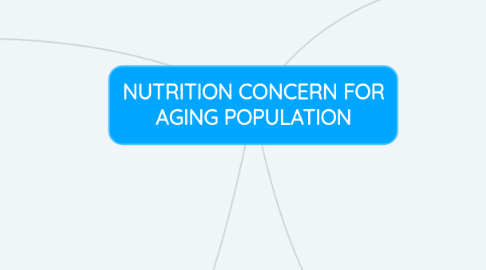
1. HEALTHY AGING
1.1. Physical Activity
1.1.1. Benefits
1.1.1.1. Improve weight management & physical fitness
1.1.1.2. Enhance balance & functional capacity
1.1.1.3. Prevent various chronic diseases
1.1.1.3.1. Stroke, diabetes & depression
1.1.2. Factor
1.1.2.1. Retirement
1.1.2.1.1. Advantage
1.1.2.1.2. Disadvantage
1.1.3. Recommendation
1.1.3.1. Moderate intensity
1.1.3.1.1. 150 minutes/week
1.1.3.2. Vigorous intensity
1.1.3.2.1. 75 minutes/week
1.1.3.3. Moderate-vigorous intensity
1.1.3.3.1. Aerobic activity
1.2. Calories Restriction without Malnutrition
1.2.1. Slowed down "intrinsic aging"
1.2.2. Lower [serum] of LDL, cholesterol & fasting glucose
2. APPROACHES FOR IMPROVEMENT
2.1. Nutritional Screening
2.2. Nutritional Complete Supplement
2.3. "Meals on Wheels"
2.4. Food Enrichment
2.4.1. Increase in E density of meal
2.5. Aging Friendly Society
2.5.1. Aging-in-place
2.5.1.1. Home & community combined concept
2.5.1.2. Elderly friendly community
2.5.2. Information technology (IT) equipped mobile geriatric services
2.5.3. Health policy
2.5.3.1. Dietary intervention on reduction of Na consumption
2.5.3.2. Tobacco free area
3. CHALLENGES IN MAINTAINING DIETARY NEEDS OF OLDER ADULT
3.1. A loss of appetite & changes in taste and smell
3.1.1. Lead to limited food choices & lower intake of healthful food.
3.2. Oral health decline & reduced ability to swallow
3.2.1. Affect food choice & food intake
3.3. Experiencing mobility constrains
3.4. Low income
3.4.1. Difficult to access high quality food
4. COMMON PROBLEMS AMONG ELDERLY
4.1. Malnutrition
4.1.1. -ve impact
4.1.1.1. Decreased quality of life.
4.1.1.2. Vulnerability to infections
4.1.1.3. Healthcare costs
4.2. Sarcopenia
4.2.1. Definition
4.2.1.1. Multifactorial condition involving age-related declines in muscle mass, strength/function
4.2.2. Factors
4.2.2.1. Inadequate protein intake
4.2.2.2. Low physical activity
4.2.3. Intervention
4.2.3.1. Increase protein intake to inhibit muscle protein breakdown
4.2.3.2. Resistance & aerobic exercise

